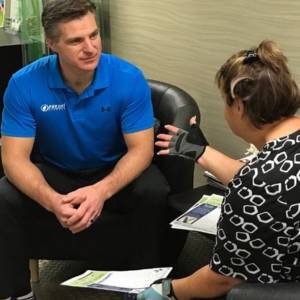Today I want to address something that I feel is straightforward, but that few people consider. The Covid restrictions time is behind us and a lot of people are wondering how to start going to the gym. I would like to share with you three things you should do before ever stepping your foot in a gym.
When people talk about getting fit, it’s often an assumption that they need to “go to the gym”.
I wholeheartedly disagree with this.
Sure, a gym can be a great tool, but the large majority of people do not need a gym or a gym membership to reach and exceed their health and fitness goals.
Here are 3 factors to consider before you start going to the gym (or purchase a gym membership).
-
Get Clear on your WHY
If you’ve read any of my posts before, you likely know that MINDSET is the most important of the 4 Pillars of Personal Performance.
One of the key factors in creating a positive, performance-oriented mindset is to clearly understand your WHY.
Your WHY is what makes you tick.
It’s what fires you up, gets you excited, and keeps you motivated and inspired to do the work towards accomplishing your most important objectives.
It’s also the fuel that helps you roll over the inevitable barriers and speed bumps along your path.
With regards to “start going to the gym” and “getting in shape”, the first question to ask is WHY?
Why do you want to make this change?
What is that you want to accomplish?
Is your WHY the REAL or right reason, or merely a smokescreen that masks the true intention?

It’s critical, to be honest with yourself about this and look closely at your motivations.
Once you are clear, decide whether the gym is actually a helpful vehicle to get you there…many times it isn’t!
For example, your friend invited you out for a short hike on the weekend. And after gasping and wheezing for over an hour, you could barely keep up and she didn’t even seem out of breath. After thinking about your why and writing down many notes, you realized that for the past decade your activity levels have slowly slipped as work became busier.
You no longer make time to get outside and do the active things you used to. Your waistline has steadily increased. And you aren’t as happy about where you are with your physical condition, health, energy, and happiness.
You’ve come to the conclusion that you want to start going to the gym. It’s close to work and will get you outside the office multiple days per week as part of your journey back to health.
Plus, you understand that the gym being close to work and convenient is merely an accountability and consistency tool to help you build greater outdoor activity. As you transform to your new healthy lifestyle.
-
Put a sensible Plan in Place
Once you are clear on why you want to change, and specifically what you want to accomplish, the next step is to have a clear plan.
Whether at work or in your personal life, you may have set SMART goals before. Unfortunately, when goals aren’t connected to a WHY, they aren’t as effective.
This is because there is minimal drive or emotional connection to them. Consequently, the chances of accomplishing them are much lower.
SMART is an acronym for goals that are SPECIFIC, MEASURABLE, ACTION-BASED/ATTAINABLE, REALISTIC, and TIME-BASED.
A proper plan has these key components
- A series of SMART goals
- A combination of Outcome goals (milestones to meet) and Process goals (actions to take)
- Goals that are powerfully connected to your WHY
- Strategies and tactics are written down (and implemented) to allow you to consistently accomplish your goals

For example, if you decide that you are going to exercise 4 days per week, you may set a monthly outcome goal to complete 16 formal exercise sessions each month. Each of these sessions will be at least 20 minutes in length and you will sweat moderately during each session.
One of these sessions each week will be outside with one or more friends. You will decide between hiking, biking, running, or some other type of sport/activity.
Your process goals will be planning weekly and daily to schedule exercise times in to your calendar, making sure you account for travel, showering, and changing.
Additionally, you will send an email to 6 friends to let them know about your plans with an invitation for them to join you on your exercise adventures.
You also set a goal to write an exercise plan a month in advance, or hire a coach to create one for you that matches your specific needs.
-
Learn to Move Properly
Movement and exercise are great when done correctly…and consistently. Yet, few people actually do them correctly or consistently.
These factors are at the root of most exercise injuries and frustrations. They can be easily solved by getting the help of an expert to ensure you build a solid foundation of technique.
It’s important to be very skeptical of the advice and workout plans you find online or via social media.
Should you follow one of these programs, make sure the:
- The person providing the program is knowledgeable and experienced (they must have more than an attractive/fit physique)
- The program is right for you, and customizable to your needs
- A technique you use for every rep of every exercise is correct…even when you are fatigued
Getting expert coaching to learn to move is one of the best investments you can make in your future health and fitness.
Let’s face it, being injured sucks.
Poor technique is the leading cause of exercise injury.
A close second would be people performing programs that they aren’t physically ready for. Which often leads to poor technique due to fitness level or skill deficits needed to perform the program correctly.
In the example I’ve been using, to start off going to the gym, and the gym-based training program, you hire an expert coach for a few sessions to:
- Assess your movement patterns
- Identify any red flags for injury or dysfunction
- Create an effective program for your current needs
- Show you the correct form for the exercises in that program
- Provide you with effective tools and resources that will help you be successful between exercise sessions (nutrition, sleep, stress, recovery, lifestyle, etc.)
As mentioned, I wrote about this today because few people take the time to consider these factors.
Even though I’ve written them down and provided you with a proven framework for success, few people will take advantage of the information.
That’s OK.
Those that do will reap the rewards.
It all comes back to you. What will you do to see the results you desire?
If you want some extra help to make sure these 3 points are properly applied, my team and I are here to help.




